Trelona® ATBS Annual Bait Stations feature a superior design that leads to faster termite hits. In fact, in a university study, termites found Trelona ATBS Annual Bait Stations faster* than Sentricon® stations. In this study, Trelona ATBS and Sentricon stations were placed within 0.5 meters of an active termite colony. The study had 20 replicates and stations were checked daily over 46 days producing the results shown here.
Read More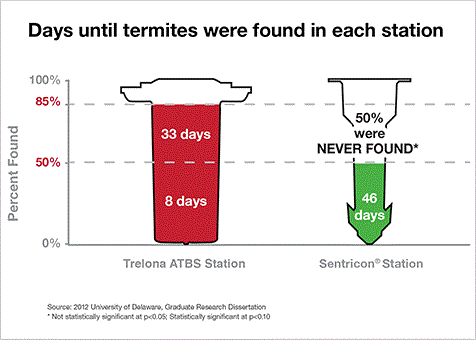
Subterranean termites live in the ground and are commonly located under and around buildings. This is quite natural. Also natural is their appetite for wood, which they are designed by nature to consume and digest. Termites and their insatiable appetite for wood create a problem only when they enter buildings in search of a new food source.
Termite barriers handle the termites looking for wood in the wrong place problem by either repelling termites that attempt to cross the barrier or by killing termites that come in contact with the barrier. To properly protect a building, a barrier must be placed under and around the entire foundation of the building where termites will encounter it as they try to enter from beneath (which they must do since the form of termites that eat wood cannot fly).
To be totally effective the barrier must be applied under and around the entire building foundation at a high enough concentration that every possible point of potential termite entry into the building is protected. But what happens if the barrier isnot continuous or is not strong enough? Good question, but you might not like the answer.
Even the most carefully applied barrier treatments do not always form continuous and uniformly strong barriers between the building and the termite infested earth beneath them. This is because of the tedious nature of the application process and the difficulty of placing a barrier beneath an existing building.
Almost inevitably, gaps or breaks are left in the barrier through which termites, who are always looking for an opening and a new meal, can invade. Variations can occur in the strength of the barrier. For example, forming a continuous and uniformly strong barrier under a concrete slab floor is rarely if ever possible. This means that if a slab floor cracks at a point at which the barrier is too weak or no barrier has been applied, termites can enter the building unimpeded and often undetected until they have done large amounts of damage.
Gaps can be created in barriers when they are physically disturbed, weakened or simply wear out. For example, earth treated with a barrier toxicant may be disturbed or washed away. Even if a barrier is continuous and uniformly strong when applied, the strength of the barrier will naturally decrease over time as the toxicant naturally breaks down. Also, currently available barrier treatment products are not as long lasting as older barrier treatment chemicals that are now banned. In order to spread the barrier under the building foundation, it is often necessary to drill a large number of barrier injection holes into the foundation.
The barrier application process can sometimes even involve the removal of finished interior surfaces such as flooring and molding. Needless to say, termite barrier toxicants are toxic to more than just termites. This means that an incorrectly or carelessly applied barrier treatment can affect more than just the termites under your home.
Subterranean termites are social insects that live in colonies that may contain hundreds of thousands of individuals. Termite colony members are dispersed throughout the soil and can extend underground tunnels tens to hundreds of feet to reach feeding sites. Each termite colony contains three forms or castes, which are the workers, soldiers, and reproductives. These castes are physically distinct and perform different tasks in the termite society.
Workers are about 1/8 inch long and are blind, wingless, soft-bodied, creamy white to grayish-white with a round head. Workers are the most numerous individuals in a termite colony, and they are the termite caste that actually eats the wood. These sterile individuals forage for food and water, construct and repair shelter tubes, feed and groom other termites, care for eggs and young, and participate in colony defense.
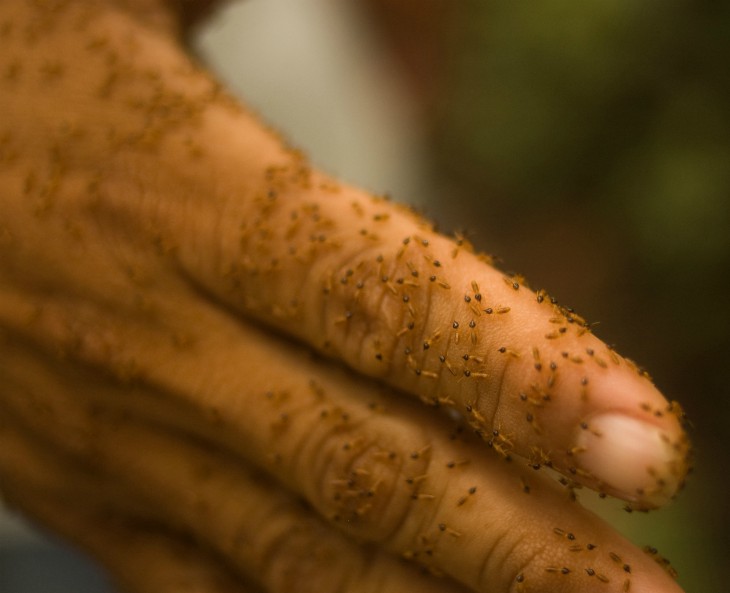
Soldiers are also wingless and resemble workers except that they have a large, rectangular, yellowish-brown head with large mandibles (jaws). The soldiers’ primary function is colony defense.
Male and female reproductives can be winged (primary) or wingless (neotenic). Each can produce new offspring. Winged primary reproductives are called alates or swarmers. However, they shed their wings soon after flight. Their body color varies by species from black to yellow-brown. The eastern subterranean termite, Reticulitermes flavipes, is the most common termite in Ohio and its alates are black and about 0.4 inch long, with pale or grayish, translucent wings. A pair of primary reproductives that heads a colony is called the king and queen. Neotenic reproductives often serve as replacements if something happens to the king and queen. Neotenic reproductives are generally yellow or mottled black and the female’s abdomen may be distended due to developing eggs.
It is important for homeowners to recognize the signs of a subterranean termite infestation. Subterranean termites may be detected by the sudden emergence of winged termites (alates or swarmers), or by the presence of mud tubes and wood damage.
Large numbers of winged termites swarming from wood or the soil often are the first obvious sign of a nearby termite colony. Swarming occurs in mature colonies that typically contain at least several thousand termites. A "swarm" is a group of adult male and female reproductives that leave their colony in an attempt to pair and initiate new colonies.
Alate emergence is stimulated when temperature and moisture conditions are favorable, usually on warm days following rainfall. In Ohio, swarming typically occurs during daytime in the spring (March, April, and May), but swarms can occur indoors during other months. However, swarming occurs during a brief period (typically less than an hour), and alates quickly shed their wings. Winged termites are attracted to light, and their shed wings in window sills, cobwebs, or on other surfaces often may be the only evidence that a swarm occurred indoors. The presence of winged termites or their shed wings inside a home should be a warning of a termite infestation.
Termite swarmers have straight, bead-like antennae; a thick waist; and two pair of long, equal-length wings that break off easily. Winged termites can be differentiated from winged ants, which have elbowed antennae, a constricted waist, and two pair of unequal-length wings (forewings are larger than hind wings) that are not easily detached. Ants also generally are harder-bodied than termites.
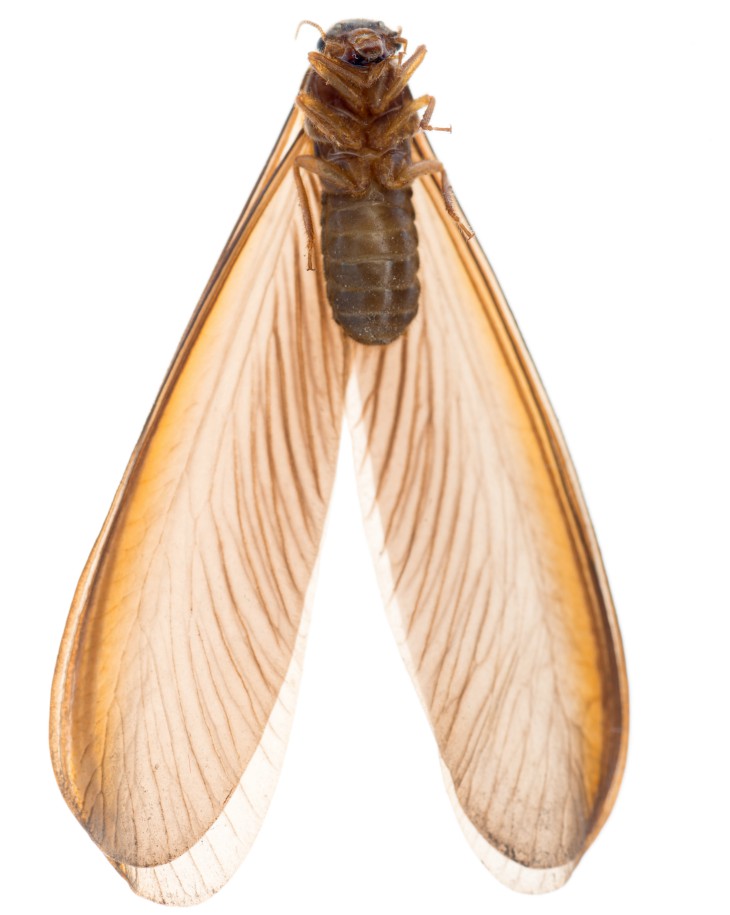
Other signs of termite presence include mud tubes and mud protruding from cracks between boards and beams. Subterranean termites transport soil and water above ground to construct earthen runways (shelter tubes) that allow them to tunnel across exposed areas to reach wood. Shelter tubes protect them from the drying effects of air and from natural enemies, such as ants. These tubes usually are about 1/4 to 1 inch wide, and termites use them as passageways between the soil and wood. To determine if an infestation is active, shelter tubes should be broken or scraped away and then monitored to determine whether the termites repair them or construct new ones. Houses should be inspected annually for mud tubes.
Termite damage to the wood’s surface often is not evident because termites excavate galleries within materials as they feed. Wood attacked by subterranean termites generally has a honeycombed appearance because termites feed along the grain on the softer spring growth wood. Their excavations in wood often are packed with soil, and fecal spotting is evident. When inspecting for termites, it is useful to probe wood with a knife or flat blade screwdriver to detect areas that have been hollowed. Severely damaged wood may have a hollow sound when it is tapped. Subterranean termites do not reduce wood to a powdery mass, and they do not create wood particles or pellets, as do many other wood-boring insects.
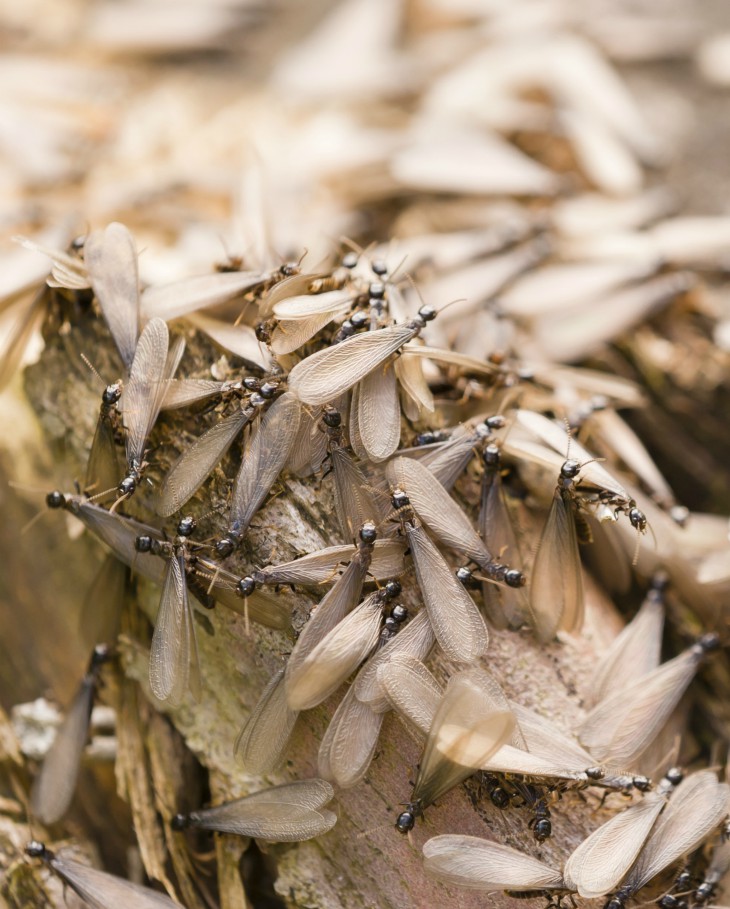
Preventive practices are a critical aspect of termite management. Prevention of subterranean termite infestation of wooden structures centers upon disrupting their ability to locate moisture, food (wood), and shelter. Avoid moisture accumulation near the foundation, which provides water needed for termite survival. Divert water away from the foundation with properly functioning downspouts, gutters, and splash blocks. Soil needs to be graded or sloped away from the foundation in order for surface water to drain away from the building.
Cellulose (wood, mulch, paper, etc.) that is in contact with soil provides termites with ready and unobservable access to food. It is very important to eliminate any contact between the wooden parts of the house foundation and the soil. Maintain at least 6 inches between the soil and porch steps, lattice work, door or window frames, etc. Never stack or store firewood, lumber, newspapers, or other wood products against the foundation or within the crawl space. Prevent trellises, vines, etc. from touching the house. Before and during construction, never bury wood scraps or waste lumber in the backfill, especially near the building. Be sure to remove wooden or cellotex form boards, grade stakes, etc. used during construction. Remove old tree stumps and roots around and beneath the building. Avoid or minimize use of wood mulch next to the foundation.
Termites feed slowly so there is no need to panic if they are discovered in one’s home. A few weeks or months may be needed to decide on a course of treatment, which typically requires employing a professional pest management firm. Consider getting at least three estimates before signing a contract for control measures, and be cautious of price quotes that are substantially lower or higher than the others. Prices for inspection, treatment estimates, and conditions of warranties often vary considerably. A guarantee is no better than the firm who presents it. It is important to take your time to select a reputable pest management firm. Deal only with licensed, certified pest management firms having an established place of business and a good professional reputation. Ideally the firm will belong to a city, state or national pest management association. It is a good idea to consult the licensing agency in your state to determine a firm’s complaint history.
Conventional soil treatments rely on creating a chemical barrier in the soil that is toxic to termites contacting it. Many also have repellent characteristics and termites avoid treated soil. To achieve termite control for long periods of time, such termiticides must be applied as a continuous barrier in the soil next to and under the foundation. If there are untreated gaps in the soil, termites may circumvent the chemical treatment. Hence, such treatments during preconstruction can provide for more uniform coverage. Once a home is constructed, the chemical has to be injected through drill holes and trenching around the foundation, which can result in less accurate coverage. Effective termite control usually requires specialized equipment and often 150 or more gallons of prepared termiticide solution per house, depending on size, basement, etc.
Termiticides that act by creating a chemical barrier in the soil include bifenthrin (Talstar®), cypermethrin (Demon®, Prevail®), and permethrin (Dragnet®, Prelude®). Chlorpyrifos (Dursban®) can be used only during preconstruction and only until December 31, 2005.
In reference to "spot treatments only" using chemical barrier termiticides only in areas of the house where termites are seen, most pest management firms will refuse such treatments or will not guarantee such treatments. The reason is that termites have a very high probability of finding other untreated points of entry into the structure. Localized spot treatments are considered risky except in re-treatment situations.
The most recent termiticides to be marketed are non-repellent to termites, but show delayed toxicity as termites forage through treated soil, which they do not avoid. As termites penetrate the "treated zone," they contact the active ingredient, which causes delayed mortality and also possibly allows the termites to be overcome by lethal microbes. Furthermore, the toxicant is thought to be passed to nestmates through grooming activities and social food exchange (trophallaxis). Control usually is achieved within 3 months. As with soil barrier termiticides, specialized application equipment and large volumes of chemical solution are needed.
Non-repellent termiticides include fipronil (Termidor®), imidacloprid (Premise®), and chlorfenapyr (Phantom®).
Bait technology uses wood or a cellulose matrix favored by termites that is impregnated with a slow-acting toxic chemical. Termite workers feed upon the bait and transfer it by grooming or trophallaxis to other colony members, eventually reducing or eliminating the entire colony. Termites are not site-specific, but rather, they forage among various food sites, which results in the bait being encountered by many colony members. The toxicant necessarily is slow acting because termites tend to avoid sites where sick and dead termites accumulate.
Typically, in-ground stations are inserted in the soil next to the structure and near known or suspected sites of termite activity. In-ground stations often initially contain untreated wood that serves as a monitoring device. The monitoring wood is replaced with the toxicant once termites have been detected feeding on it. In addition, aboveground stations may be installed inside or on the structure in the vicinity of damaged wood and shelter tubes. Aboveground stations initially contain bait.
It is very important that bait systems are properly installed and diligently serviced. Monthly inspections of a baiting system usually are necessary, except during inclement winter weather. Successful termite baiting necessitates proper monitoring and maintenance of the stations.
Baits work much more slowly than soil termiticides and the homeowner should be aware of the possibility of a lengthy baiting process. Several months or more may elapse before the termites locate stations, then termites must feed on sufficient amounts of the toxicant.
is that they are "environmentally-friendly" because they use very small quantities of chemical and decrease the potential for environmental contamination. In addition, bait application causes little disruptive noise and disturbance compared to soil treatments. Furthermore, baits can be used in structures with wells or cisterns, sub-slab heating ducts, and other features that may preclude a soil treatment. Baits are often used in sensitive environments.
control termites. Bait products that are available for licensed pest management professionals include the Sentricon® Termite Colony Elimination System (hexaflumuron [Recruit® II bait] or noviflumuron [Recruit® III bait]), FirstLine® Termite Defense System (sulfluramid), Exterra® Termite Interception and Baiting System (diflubenzuron [Labyrinth® bait]), Subterfuge® Termite Bait (hydramethylnon), and Outpost® Termite Bait Response (diflubenzuron). Not all of these bait systems are equally effective. It is advisable to review the independent research that has been conducted on a particular bait, as some products have been evaluated much more rigorously than others.
Termirid® 613 (borate) can be purchased by homeowners. However, Terminate® is not recommended as sole protection against termites, and an active infestation should be treated by a professional. Termirid® can be used to reduce subterranean termite populations. Little or no research has been conducted to verify the effectiveness of these products, particularly when used by homeowners.
Borates (disodium octaborate tetrahydrate [Tim-bor®, Bora-Care®, Jecta®], Impel®) and pressure-treatments (creosote, chromated copper arsenate [CCA]) protect wood against termites and wood-decay fungi. However, even creosote-treated railroad ties and telephone poles, and CCA-treated wood, over time, can be subject to termite attack. Termites can build mud tubes over treated surfaces. Furthermore, they can gain entry through cut and cracked ends or areas where the chemical has not sufficiently penetrated.
Wood treatments are primarily used to supplement other termite control measures, because termites are able to attack untreated wood in other areas of the structure. It is advisable to use pressure-treated wood in situations where wood is in direct contact with soil or exposed to rainfall. Borates are fairly soluble in water, so borate-treated wood should be protected from constant rewetting.
Physical barriers are particularly appropriate during the preconstruction phase to provide protection of the structure from subterranean termites. One such physical barrier is stainless-steel wire mesh (TermiMesh®) that is fitted around pipes, posts, or foundations. The newest physical barrier, Impasse® Termite System, contains a liquid termiticide (lambda-cyhalothrin) locked in between two layers of heavy plastic that is installed before the concrete slab is poured. It is supplemented with Impasse® Termite Blocker, which uses special fittings around plumbing and electrical pipes and conduits.
Certain species of parasitic round worms (nematodes) will infest and kill termites and other soil insects. They have been promoted and marketed by a few companies. Although effective in the laboratory, control is often quite variable under field conditions. Limited success with nematode treatments may be attributed to the ability of termites to recognize and wall-off infected individuals, hence limiting the spread of nematodes throughout the colony. Furthermore, soil moisture and soil type appear to limit the nematode’s ability to move in the soil and locate termites.
A fungus Metarhizium anisopliae (Bio-Blast®) is a biological termiticide that requires special application and handling techniques. It is labeled for aboveground application to termite infestations in structures, but it is not labeled for application to the soil. Spray effectiveness is enhanced when applied to many foraging termites because infected termites can pass the fungus to nestmates. However, it is difficult to infect a large enough number of termites for the infection to spread throughout the colony. Furthermore, it provides no long-lasting residual activity, and the fungal spores die with the dead termites. Insufficient research has been conducted to indicate whether this is an effective method for controlling termites.
Some termite baiting systems disturb termites feeding in their stations whenever they are inspected or baited. This is because their station design requires that their interceptors must be removed and reinserted during inspections and removed and replaced with bait when the station is actually baited. With Exterra this is not the case. Little or no disturbance at any time. Period.
Most types of toxicants are quick acting, meaning they kill an insect soon after the insect contacts or consumes it. A quick acting toxicant placed in a termite bait would cause the immediate death of any termites that found and started consuming the bait. Other colony members of the now dead termites arriving at the bait looking for food would discover their dead nest mates. These newly arriving termites would quickly realize that the bait was causing the death of their nest mates. These termites and all their other nest mates would then instinctively avoid consuming the bait. This would mean the bait had killed some termites but had failed to eliminate the colony.
How can this colonyprotective instinct be successfully defeated? To date the best strategy developed is to select a toxicant for use in the bait which acts slowly. If a toxicant acts slowly enough, termites consuming the toxicant containing bait are able to leave the Station before being affected by the toxicant. Optimally, these termites are able to return to the colony where in keeping with their colony duties they deliver food back to other colony members. Food that just happens to be toxicant-containing bait. If the toxicant in the bait works slowly enough, the colony is unable to learn to avoid eating the bait because they can't connect the death of more and more colony members with the consumption of the bait. The slow (but not too slow) speed of action of the termite bait toxicant used with Exterra (plus other attributes) makes it an optimal termite bait toxicant.
Large animals have bony interior skeletons. But insects, including termites, have an exterior skeleton, referred to as an exoskeleton. As they grow, termites must shed their exoskeleton to form a new replacement exoskeleton. This exoskeleton replacement process is called molting. A failure to complete the molting process is always lethal to termites. This means that a toxicant that stopped termites from successfully completing the molting process would be a reliable termite bait toxicant. The toxicant contained in Labyrinth Termite Bait, the bait component of Exterra, has this exact action. But how does it act slowly enough to eliminate the colony?
After consuming Labyrinth, a termite is killed when it molts. However, not all of the termites in a colony molt at the same time. Because some termites in the colony molt sooner and others molt later, the termites die at different times. As more and more colony members that have consumed Labyrinth molt and die, the number of surviving colony members is whittled down.
Finally when only a few colony members are left, the colony normally collapses and is eliminated. Because the whittling down process occurs slowly, it is almost impossible for the then surviving colony members to identify and avoid the substance that is causing the slow, gradual loss of other colony members.
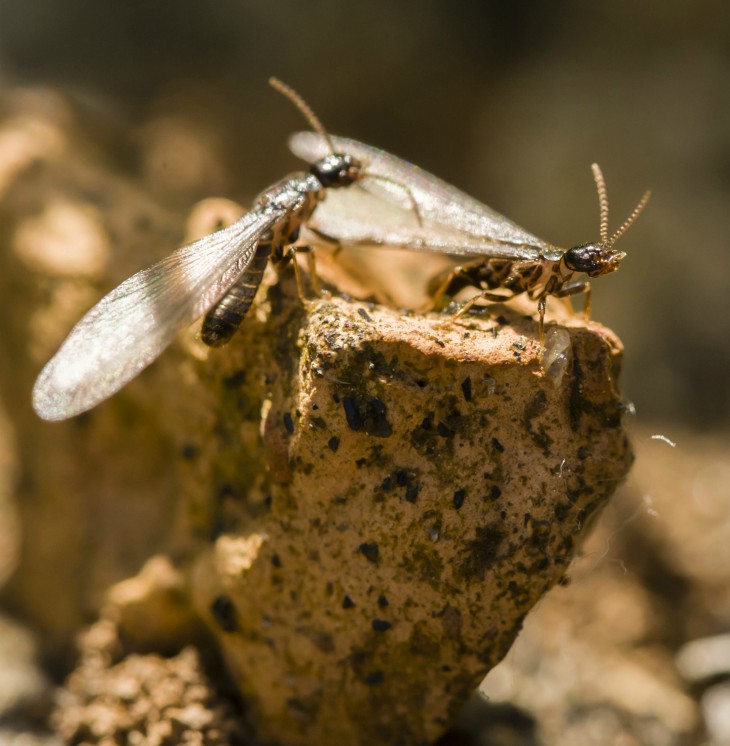
Labyrinth can take several months or more to completely eliminate a termite colony. However, it can drastically reduce the rate of wood consumption of a colony within six to eight weeks after the colony starts consuming Labyrinth. This is because while termites may take several months to molt and die after consuming Labyrinth, its active ingredient has other (too complicated to explain here) effects on termites that begin within a few weeks of when termites first start to consume it.
These effects interrupt a termite's ability to consume wood meaning, the amount of damage a termite colony is doing to a building it's infesting is reduced well before it actually eliminates the colony.
The active ingredient used in Labyrinth is very powerful. So powerful that it needs to be present in Labyrinth only at a very low concentration. This concentration is so low that the amount of Labyrinth needed to completely fill one Exterra Station contains less than one ounce of toxicant. But the active ingredient is low in toxicity to humans.
But how can the active ingredient in Labyrinth be so effective in killing termites yet so low in toxicity to humans? Because the active ingredient has an action only against animals that molt and humans do not molt! As mentioned earlier, the active ingredient in its pure, concentrated form is less toxic than table salt.
Labyrinth can eliminate all the termite colonies under and around a building. However, after a colony is eliminated, ground areas that the eliminated colonies previously occupied may be invaded by new termite colonies. This is why the interception and baiting process must be continued at your building even after the termite colonies active under it now are eliminated.
Termite colony elimination is the most important advantage of Exterra. However an important added bonus of using Exterra is the significant reduction in the amount of toxicant necessary to manage termites at a site when compared to barrier treatments. Just how large are these potential reductions? Let's take an example. Some barrier treatments can involve the application of more than 10 pounds of actual chemical toxicant mixed with hundreds of gallons of water around a typical house. But Exterra replaces all this with a few ounces of active ingredient. In some situations, using Exterra in place of a barrier chemical product can result in up to a 10,000 fold reduction in the amount of toxicant needed to control termites at a site. Real reductions in exposure of applicators and the environment to termite control toxicants can be achieved when Exterra is used in place of a chemical barrier treatment. Good for you, your family, and the environment.
A little bit of Termidor goes a long way in treating your home or business.
Get a Quote